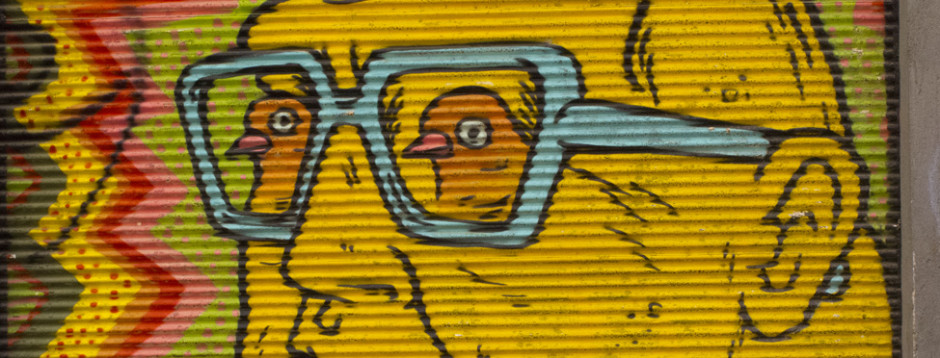
Meryl Meisler, “The Village People Stepping Out” (The Grand Ballroom, Manhattan, June 1978), and detail of “Three Amigos” (Bushwick, Brooklyn, 1983) (all images courtesy the artist)
In the late 1970s and early 80s, Meryl Meisler, then a young photographer and self-described club kid, began documenting the bacchanalian nightlife of the city’s most notorious downtown clubs. In the early 1980s, as a New York public school teacher, she also started photographing the near-total devastation of Bushwick, Brooklyn, a neighborhood looted, burned, and abandoned by the city and its landlords. The resulting dual body of work is now a stunning book and exhibition, opening on Friday, May 30 at Bizarre Black Box in Bushwick.

Meryl Meisler, “Wild Wild West Cowgirl at Rest” (Hurrah, Manhattan, March 1978)
The juxtaposed imagery of Meisler’s two worlds is mesmerizing. Arranged in pairs, the photographs echo one another in ways both emotionally compelling and visually fascinating. In “Three Amigos” (Bushwick, Brooklyn, 1983), three young men pose triumphantly in front of a boarded-up building covered in graffiti. On the opposing page three members of The Village People exit a club in full, iconic regalia. Drag queens pose invitingly, mirrored by cheerful giggly teenage Bushwick girls in an eerily similar stance. Two worlds, so close and so distant, married by a single, discerning artist’s lens.
Meisler shot the club world primarily in luminous black and white. The resulting high-contrast prints depict a world going gleefully to hell. The photos are raw in both contrast and content, capturing a soulless hedonism. Everyone is having “fun,” but when you look closely, the fun is hard to find.

Meryl Meisler, “Turquoise Ring” (Studio 54, Manhattan, August 1977)
The Bushwick photos were shot with a cheap camera and 35 mm color slide film, then transferred to prints. Meisler’s process yields images with a rich warm glow. The saturate colors of life in Bushwick belie a desperately poor and hard-edged world, but somehow a visual warmth blankets in the content of Meisler’s photos. Though never sentimental she conveys empathy and generosity towards her adopted neighborhood.

Meryl Meisler’s “Elbows at Angles” (Infinity, Manhattan, August 1977) and “Two Girls Strike a Pose” (Bushwick, Brooklyn, June 1986)
This exhibition is a terrific document of life in NYC during an era past. At the same time it serves as a potent metaphor for life in post- Bloomberg NYC . Bushwick is no longer burnt out, and the Manhattan club scene is long gone, but New York remains a tale of two cities. Ironically Bushwick, now too pricey for many of its historic residents is now a haven for artists, galleries and foodies, themselves displaced by a Manhattan of oligarchs and overpriced real estate. Thirty years later, and still the best of times and the worst of times.

Meryl Meisler, “Roller Skates” (Bushwick, Brooklyn, circa 1984)

Meryl Meisler, “Prom Queen Contender” (Les Mouches, Manhattan, June 1978)

Meryl Meisler, “High Hat Hands Raised” (Bushwick, Brooklyn, April 1982)
A Tale of Two Cities: Disco Era Bushwick runs May 30–September 10, 2014, at Bizarre Black Box Gallery (12 Jefferson Street, Bushwick, Brooklyn). There will be a Disco Night Opening Reception on Friday, May 30, 7p–4a, with performances and special events throughout the weekend. A monograph of Meisler’s work will be published in conjunction with the show.





 Portraits of his children, I think. Bling bling Iranian style.
Portraits of his children, I think. Bling bling Iranian style. . Jerusalem is beautiful. A stunning world class museum- The Israel Museum. A really edgy, brilliant contemporary art museum called The Seam. It’s right on the “seam” between east and West Jerusalem and devoted to showcasing political and socially relevant art. The current show is about the notion of Loneliness, and it’s very moving. There’s ancient history. A terrific art school. Good restaurants. Elegant neighborhoods. And lots and lots of soldiers and tension. When I arrived the bus station was in full scale bomb alert. They take that pretty seriously in Israel. It’s sobering and a million miles away from the fun and funky world of Tel Aviv. I found the city very sad. But here’s some snaps of Arab school girls at the Israel Museum, taking pictures of each other and blissfully ignoring their teacher. Some things are the same the world over.
. Jerusalem is beautiful. A stunning world class museum- The Israel Museum. A really edgy, brilliant contemporary art museum called The Seam. It’s right on the “seam” between east and West Jerusalem and devoted to showcasing political and socially relevant art. The current show is about the notion of Loneliness, and it’s very moving. There’s ancient history. A terrific art school. Good restaurants. Elegant neighborhoods. And lots and lots of soldiers and tension. When I arrived the bus station was in full scale bomb alert. They take that pretty seriously in Israel. It’s sobering and a million miles away from the fun and funky world of Tel Aviv. I found the city very sad. But here’s some snaps of Arab school girls at the Israel Museum, taking pictures of each other and blissfully ignoring their teacher. Some things are the same the world over.













 Coffee bar, Akko Style. Extraordinarily good coffee, served with side dishes of baklava and pickles. A taste combo I never need to repeat.
Coffee bar, Akko Style. Extraordinarily good coffee, served with side dishes of baklava and pickles. A taste combo I never need to repeat.








 Every Mosque should have a cat in a basket!
Every Mosque should have a cat in a basket!
 Meanwhile, above ground. The seawalls, seafood restaurants cling to the side of the city, the sea lapping up against them.
Meanwhile, above ground. The seawalls, seafood restaurants cling to the side of the city, the sea lapping up against them. Sweets, fish nets, street posters, seafood, a wall of seashells, shops
Sweets, fish nets, street posters, seafood, a wall of seashells, shops 
















































 Crazy great sculpture made out of vintage children’s chairs-
Crazy great sculpture made out of vintage children’s chairs-









